If you aren't using YouTube to promote your online courses, you're missing a major opportunity to reach a bigger audience. You must know how to use YouTube to reach more students and grow your educational business.
As the world’s top video-sharing site and second-biggest social platform, YouTube reaches over 2.70 billion monthly users. Data also reveals that YouTube ranks as the second most visited website.
Let’s consider that you have your own course website. So, it’s high time you should utilize the most out of YouTube! To guide you, we’ll reveal how to use YouTube to sell courses in 2025. Let’s dive in.
YouTube Course Promotion Essentials
Here are the key things that you should consider while promoting your online courses on YouTube:
Create valuable free YouTube content to build trust and authority
Use clear calls-to-action in every video to guide viewers into your courses
Optimize titles and descriptions with relevant keywords
Share your original course website’s link in each video description
Engage with comments to build community and relationships
Collaborate with other creators in your niche for expanded reach
Track performance metrics to refine your strategy continuously
Try to influence people to enroll in your premium courses
Why YouTube Matters for Your Course Business?
Why should you start a YouTube channel to advertise your courses? Aren’t other platforms enough? The reality is that they might not compare. Here are the key reasons:
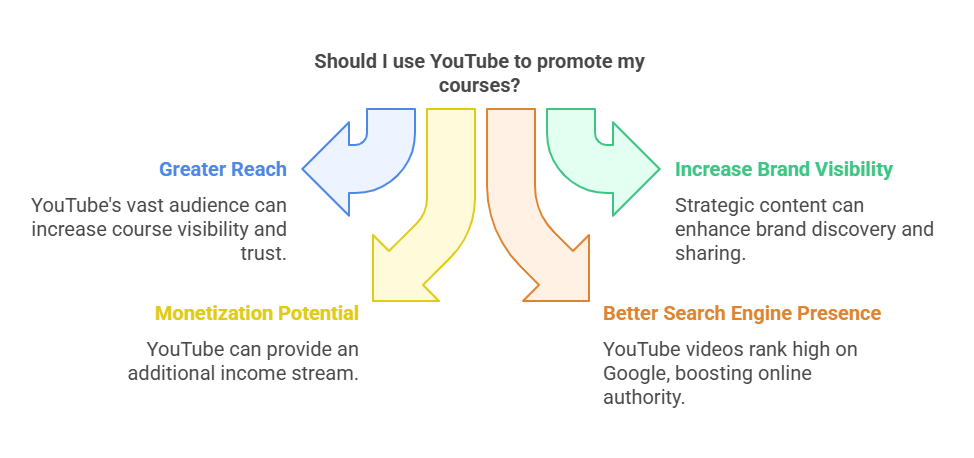
1. Greater Reach to the Audience
YouTube reaches more than two billion people each month. By sharing free, valuable videos, you can prove your expertise and earn your viewers’ trust. This trust can lead to steady course sales.
YouTube also costs less than hosting your own platform. Its video format keeps your audience interested and learning. You can build a sense of community by talking with viewers in comments and community engagement posts.
As your channel grows, you can scale your course sales with a little extra work. In short, YouTube offers huge reach, high engagement, and a strong sense of community.
2. Increase Brand Visibility
Using well-thought-out tactics and showing patience can help more people discover your courses on YouTube. By creating content that helps potential learners, you’ll find your videos placed on top.
If viewers find these videos useful, they’ll share them, giving you free publicity. Your course brand can then flourish, especially if you add brand elements in later steps. Plus, you can bring more traffic to your course website from your YouTube channel.
3. Monetization Potential
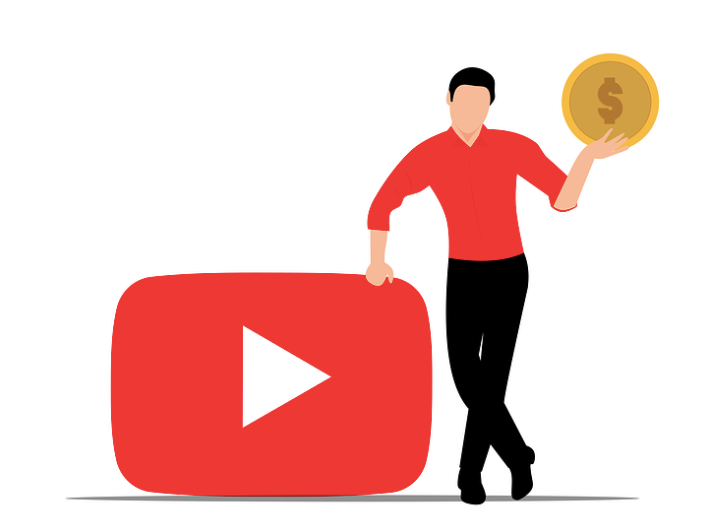
YouTube offers monetization that can serve as an extra income source. You do need at least 1,000 subscribers and 4,000 public watch hours within a year. So, it’s another way to earn revenue from your channel.
4. Better Search Engine Presence
Google often places YouTube videos high in its search results. This means you can gain online authority by embedding YouTube clips in your teaching site. As a result, you increase awareness of your course offerings.

How to Use YouTube for Course Marketing (10 Actionable Tips)
If you are serious about course marketing, don’t forget to learn how to sell courses on YouTube. Below are 10 reliable tactics to help you engage future learners.
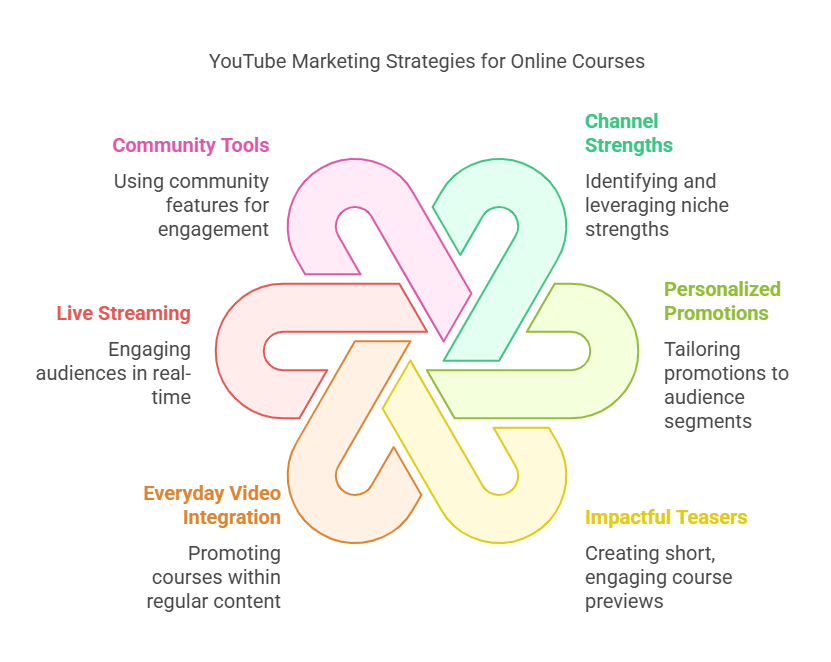
1. Pinpoint Your Channel’s Strengths
First, you must identify your channel’s niche. Maybe you teach tech skills, a new language, or workout routines. Focus on what you do best.
Next, study your audience. Dig into age ranges, locations, and interests using your channel’s analytics.
Check which of your videos gets the highest number of likes, comments, and shares. Those metrics reveal the topics your viewers love most.
Decide which video style resonates with them, tutorials, short form videos, or reviews, and use that format to promote your course.
2. Personalize Your Course Promotions
Take what you’ve learned about your audience and shape your content to match their needs. If your viewers are young professionals, highlight how your course can speed up their career growth.
Segment your audience. For example, if you offer personal finance lessons, speak to beginners about debt management, and then show advanced students strategies for options trading.
Use language and examples that mirror their day-to-day experiences. Personalized messages increase the odds of viewers becoming enrolled students.
3. Produce Impactful Teasers
Short teaser videos on YouTube can spark immediate interest. Give a quick glimpse of your course content, such as a unique module or special teaching style.
Keep the message concise and clear. Show them exactly how they’ll benefit from your lessons.
You can also use AI teaser video makers to simplify teaser creation. Include short testimonials from happy students. This social proof builds trust in your course. Always wrap up with a direct call to action. Tell your viewers where to enroll or how to get more information.
4. Weave Your Course into Everyday Videos
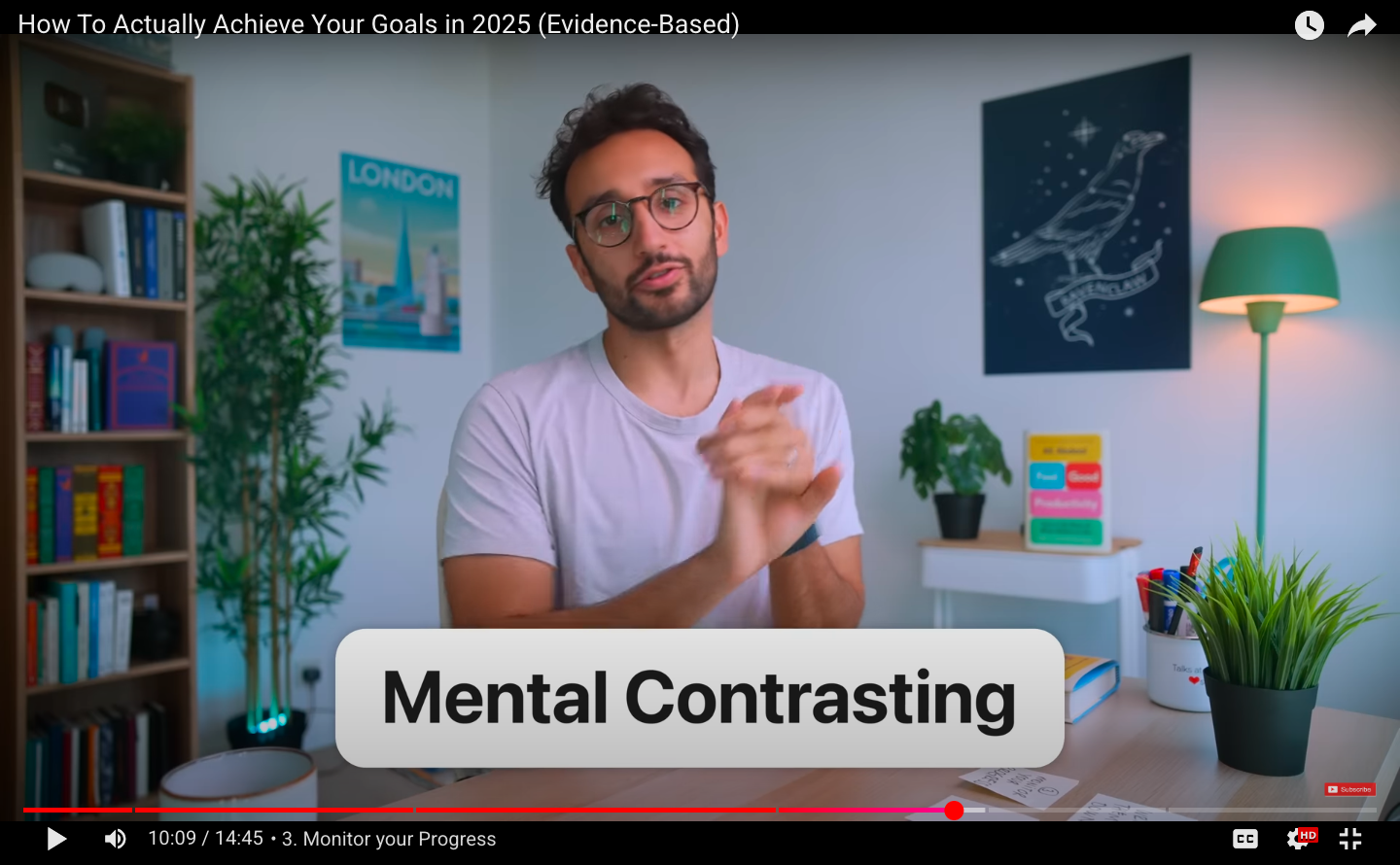
Place mentions of your course naturally within your usual uploads. If you host a cooking channel and offer advanced cooking lessons, mention how you cover certain techniques in full detail in your course while demonstrating a related dish.
These references should feel genuine and fit the topic at hand. You should highlight clear benefits. Show how your course helps viewers solve a specific problem or master a tricky skill. This approach makes your promotion feel organic instead of forced.
However, avoid relentless selling. Constant pitches can push people away. Subtle, relevant mentions are far more effective than turning every video into a sales ad.
5. Use Live Streaming for Real-Time Bonds
You can directly and easily interact with your viewers through YouTube Live sessions. Answer questions on the spot to build immediate rapport with the viewers and showcase your expertise.
Host demonstrations or invite guests who align with your course content. This variety keeps live streams fresh and engaging. Throughout the broadcast, you can encourage audience input and respond to their comments in real-time.
6. Tap into YouTube’s Community Tools
Your channel isn’t limited to videos alone. Use the Community tab to post updates, ask questions, or run polls related to your course material.
This space keeps followers involved between uploads and helps you gauge their interests. Poll results can guide you in refining your course topics or adding fresh material.
Regular engagement in the Community tab shows you’re attentive and eager to connect. This sense of closeness motivates viewers to explore your offerings further.
7. Collaborate with Other Creators
Collaborate with YouTubers who share an audience similar to yours. If your course is about personal finance, for example, work with finance or business channels so their viewers will find your content relevant.
You can do co-created videos, guest appearances, or simple mentions in each other’s content. Provide genuine value in these collaborations. People can tell if you’re only selling.
Through partnerships, you gain new eyeballs for your course and build relationships that might open future opportunities. It’s a mutually beneficial way to grow.
8. Increase Visibility with Targeted YouTube SEO
Well-planned SEO can make your course easier to discover. You should research keywords closely tied to your subject. Then, integrate the keywords into your video titles, descriptions, and tags.
To increase visibility with targeted YouTube SEO, you can do the following:
Produce attention-grabbing thumbnails and write clear, detailed descriptions.
Ensure your viewers can easily find the direct links to your course or enrollment page.
Through different informative videos, you should encourage viewers to like, comment, and share. Positive engagement signals can improve your standing in YouTube’s search results.
Check YouTube Analytics often.
Track watch times, audience demographics, and traffic sources.
Use what you learn to adjust titles or keywords, continually improving discoverability.
9. Share Exclusive Perks with Subscribers
Subscribers deserve special treatment. You should offer them unique course materials, bonus videos, or behind-the-scenes looks at lessons. This will develop a sense of belonging and reward loyalty.
People will also enroll in your course if you offer discount codes or early-bird deals. These offers make subscribers feel valued while driving urgency.
Cultivate a “members-only” vibe. When people know they’re getting something truly special, they’re more likely to spread the word and stay subscribed.
10. Track Results and Fine-Tune Your Strategy
All marketing efforts need measurement. You must set clear targets, such as more course enrollments or higher average watch time.
Check YouTube Analytics to see which videos spark the most reactions, questions, or sign-ups. Watch for retention patterns and peak engagement moments.
If certain topics or formats drive better conversions, produce more of them. If others fail to gain traction, adjust or drop them.
Stay flexible, and let data inform your choices. By refining your approach based on tangible outcomes, you’ll steadily enhance your course promotion efforts on YouTube.

How to Optimize Your YouTube Channel for Selling Online Courses?
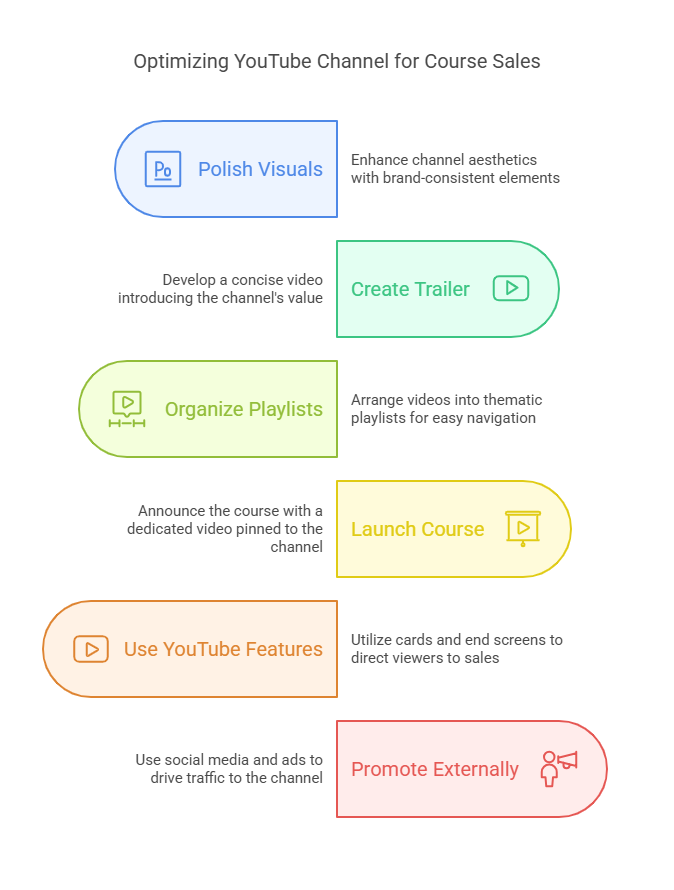
Intense videos alone aren’t enough. You also need a YouTube channel set up that moves people to buy your course.
First, polish your visuals. Use a clean channel icon and banner that match your brand. These elements introduce your style right away.
Next, create a short trailer. Aim for 30 to 60 seconds. Explain who you are, what you teach, and why people should subscribe. It should auto-play for new visitors so they see your value fast.
Then, group related videos into playlists. This helps viewers find what they want to learn without searching. If you’re prepping for a course launch, make a playlist to show off relevant content and spark curiosity.
When it’s time to launch, post an announcement video. Pin it to the top of your channel. Highlight what your course covers, how it helps learners, and how to join. Place the sign-up link in your video description. Use cards and end screens to send viewers straight to your sales page or related videos.
Beyond YouTube, promote your channel on social media, run targeted ads, or partner with like-minded creators. This drives more traffic and potential buyers your way.
Start by Sharing Your Online Courses with YouTube Trailers and Teasers
You’ve worked hard to create a great course. Now, it’s truly time to share it with everyone! A brief trailer on YouTube can spark curiosity and direct viewers to your offerings.
Short previews help people see how your course benefits them. They build excitement and encourage students to learn more. They also show your teaching style, forging a bond with future learners. They can set you apart from others in your niche.
Try these tips for compelling trailers and teasers:
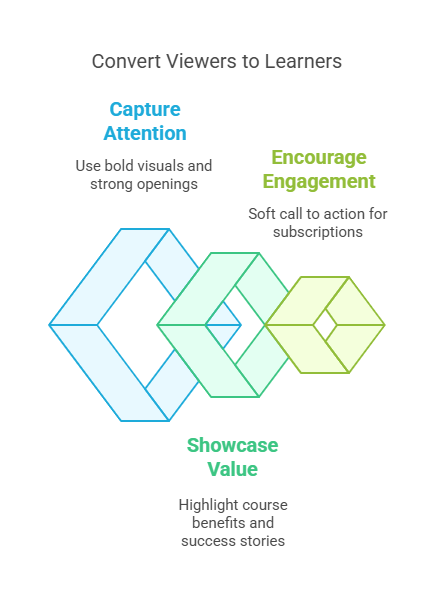
• Keep it concise: Aim for 30–90 seconds. Offer a quick channel intro and a glimpse of your course.
• Start strong: Use bold text, sharp animations, or dynamic graphics to capture attention quickly.
• Offer a soft call to action: Ask viewers to subscribe for updates instead of pushing for immediate sales.
• Focus on value: Show the main benefits and results students can achieve.
• Share success stories. Include short testimonials or examples of how past students thrived.
• Optimize for mobile: Many watch on phones, so ensure your preview looks good on smaller screens.
Posting trailers and teasers on YouTube can generate buzz and draw high-quality leads. These short clips serve as a tool to promote your online courses and spark interest. Use them to stand out and convert casual viewers into motivated learners.

How to Promote Your Online Courses on YouTube? 16 Steps
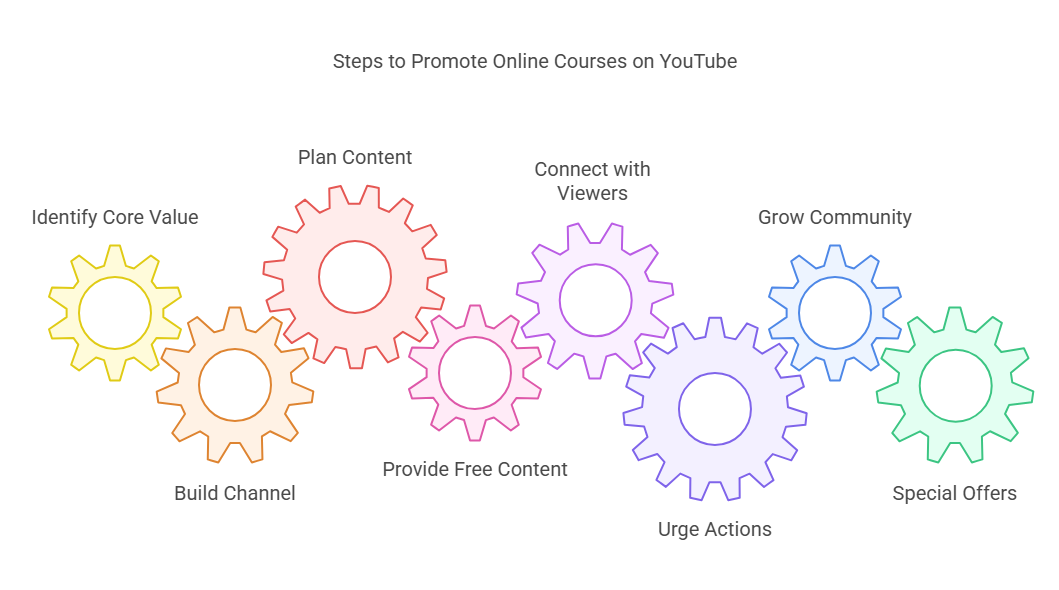
To promote your courses on YouTube, follow the 16 easy steps below:
Step 1: Identify Your Core Value
As you’re looking to know how to use YouTube for online courses, you should begin by knowing what unique benefit you bring to learners. Research other educators on YouTube. See what they teach, how they present material, and which subjects are trending.
This helps you figure out gaps you can fill. By understanding demand, you can develop a style that sets your channel apart.
Step 2: Build a Standout YouTube Channel
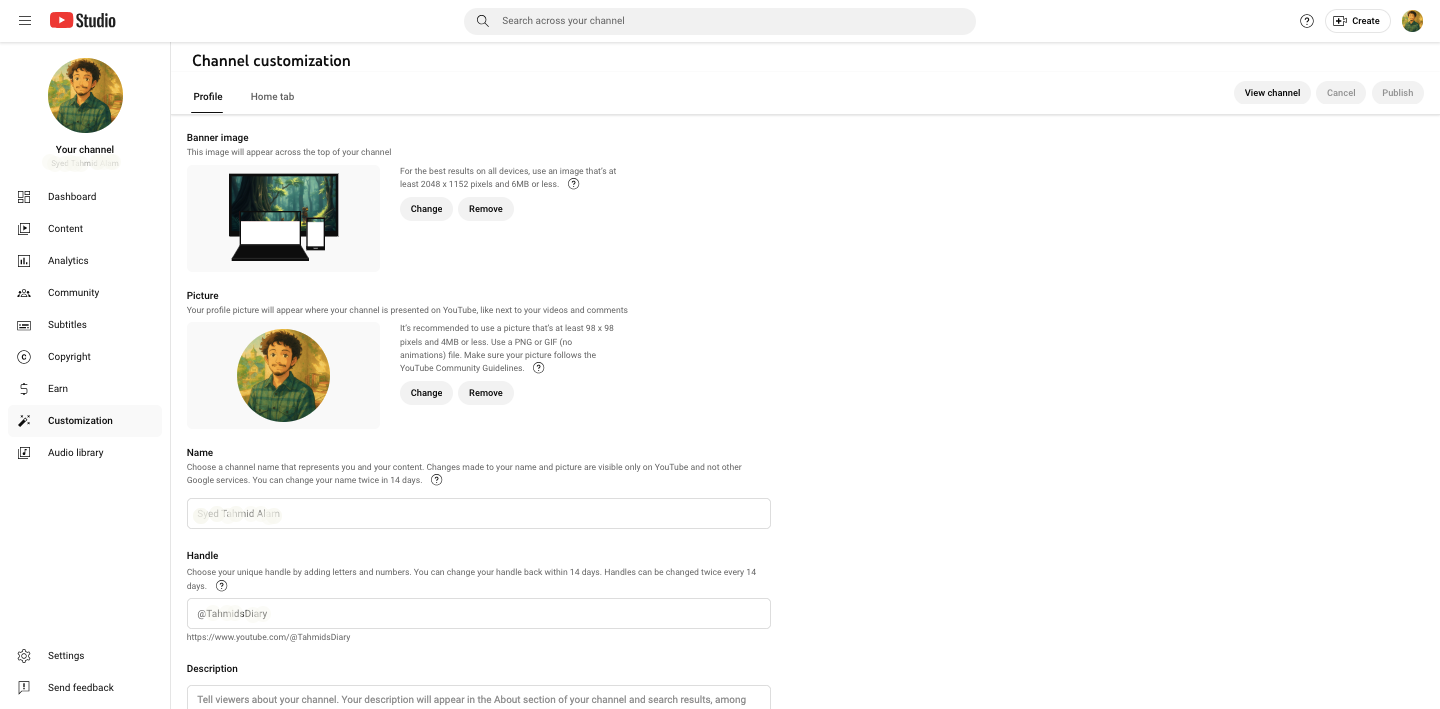
First impressions matter. Craft a brief welcome video that plays automatically when visitors arrive. Offer a quick glimpse of the knowledge or skills they’ll gain from your lessons.
If brand identity is important, design a catchy banner. Add a clear profile picture—either your own photo or a logo that represents your teaching.
Fill out the “About” section with your background, your love for the subject, and the reasons why viewers benefit from subscribing.
Step 3: Plan Your Content and Brainstorm Ideas
If you’ve ever struggled to share all your thoughts clearly, a content plan is the solution. It keeps you focused and organized.
To find inspiration, look at the “Popular” or “Most Viewed” videos from other online teachers. You can also create YouTube videos that address common questions from existing students.
This tactic adds depth to your courses. Plus, it can guide prospective learners to your channel or link them from your channel to your more advanced programs.
Step 4: Provide Free, Useful Content
Sharing valuable content without cost is a potent YouTube strategy to draw in, engage, and eventually convert viewers into paying students for your online courses.
You should begin by building trust through helpful videos on relevant topics. This positions you as both an authority in your niche and a sincere educator, not just a salesperson.
Offering free insights also grows awareness of your course and widens your audience reach. People who might never have found you can now learn from you and discover what you offer.
Step 5: Find Unique Ways to Connect with Viewers
Focus on what makes you memorable. For example, maybe you greet everyone with a specific phrase at the start or end of your videos. Consistency in such details helps your audience feel they’re part of something special.
Build trust by sharing stories, personal experiences, or fun examples. If your viewers trust you, they’re more likely to consider joining your courses. It’s not about constant sales tactics, it’s about showing your personality and expertise.
Step 7: Urge Direct Actions
People often need a simple nudge on what to do next. Tell them exactly how to move forward, like visiting your course website, downloading a guide, or posting a comment.
Tips for strong CTAs:
Begin with a clear command, like “Enroll Now,” “Subscribe,” or “Download.”
Use words that make them feel excited or curious.
Give a quick reason why they should act now.
Step 8: Grow a Devoted Community
As you post more often, you’ll see your view counts and likes rise. That’s your growing audience. Your job is to keep them involved.
Wrap up your videos with a question that sparks debate in the comments. Respond to their thoughts and host live streams to stay connected. When they feel heard, they’re more likely to stick around.
Step 9: Share Your Videos Everywhere
Once you have a new upload, share it on other networks. If you run a website or blog, embed your videos there.
Another idea is to clip longer YouTube videos into bite-sized pieces. You can post them as Shorts, Reels, or quick TikTok uploads. This can bring fresh eyes to your main channel and courses.
Step 10: Partner with Other Creators
Look for YouTubers who speak to a crowd similar to yours. Team up to make videos or do interviews. This way, their viewers meet you, and you get a fresh stream of people who might want your paid content.
Be clear on how you’ll work together. Plan something that suits both channels. Make sure you create real value, not just a sales pitch.
Step 11: Build an Effective Course Landing Page
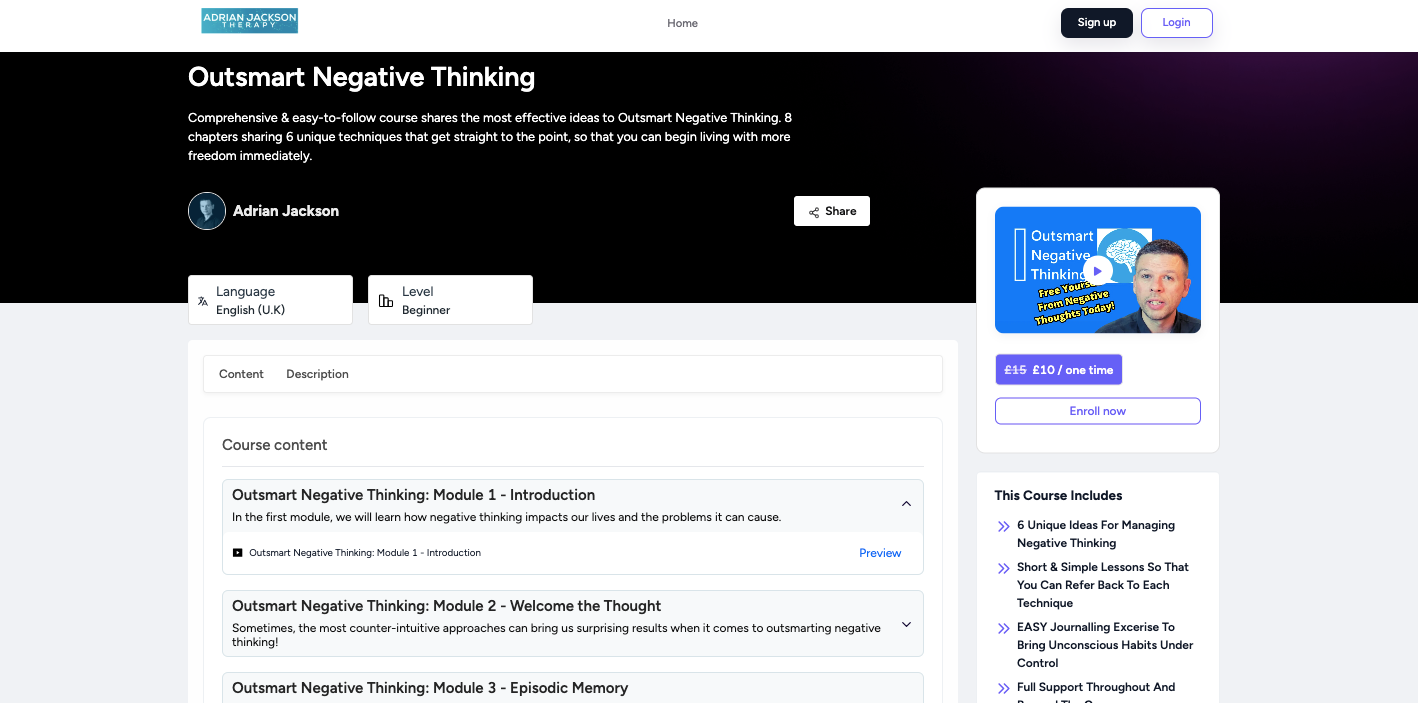
If you already have a course website, try to optimize your course landing page.
A well-built landing page can improve your success in converting YouTube viewers into paying students for your online courses. Create an effective landing page to sell online courses.
First, research industry keywords that match your topics and draw solid search traffic. Use them naturally in your landing page text to improve discoverability.
Next, pinpoint your course’s standout benefits. Explain how your program is unique compared to others on the market.
Highlight your strongest selling point right away. Pair it with eye-catching visuals: images, videos, or graphics that echo your course’s theme.
Ensure these visuals accurately represent your content. They should build trust by showing the true nature of what students can expect to learn.
By weaving in these elements, you’ll create a focused page that resonates with visitors and increases enrollments.

Step 12: Grow on Social Media and Build Community

Social sites like Twitter and Facebook can help you reach more people and spark greater engagement on YouTube. Use the same logos, banners, and tone across every platform. This way, viewers recognize your brand wherever they see it.
We recommend that you enable quick sharing of your videos with clear calls to action. Prompt viewers to pass your content along to friends or followers, increasing your overall reach. Also, make good use of YouTube’s community features.
Post updates, share fun behind-the-scenes moments, and spark conversation. When you nurture a community, you build trust. That trust leads to higher conversions because it shows potential students that your courses deliver real value.
If you are not sure how to build your own community within your own website, EzyCourse can help you. This is an all-in-one online platform comes with built-in community tools to grow your audience.
Step 13: Create Special Offers
Enticing deals can push your YouTube audience to purchase your courses. One proven method is a limited-time discount. You should emphasize the lower price and the short window. This urgency nudges people to act fast.
You could also create bundles. Combine multiple courses or extra materials at a discounted price. These bundles give more value and can sway hesitant buyers.
Another idea is early-bird pricing for new courses. Encourage people to sign up right away by giving them an exclusive rate or special perks. Free trials or sample lessons also work well. Everyone loves getting a peek without obligation.
A referral program can help you grow even faster. Offer cash bonuses or course credits to students who bring in new enrollees.
Step 14: Host Your Courses with an All-in-one Platform
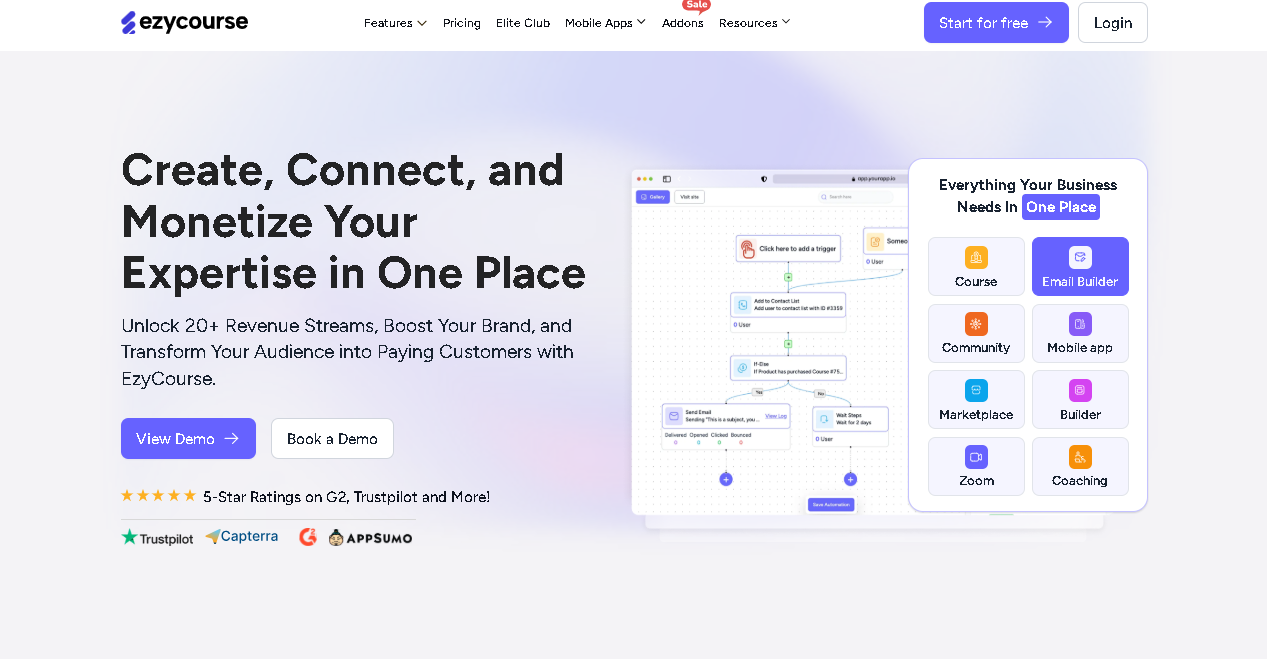
If you are already selling online courses, check whether your course platform offers you all the solutions like:
Course creation
Community building
Membership features
Mobile app
No-code site builder
Payment management
Blogging tools
SEO optimized settings
Or, if you are looking to create your own course website, go for an all-in-one platform like EzyCourse, which handles everything from course hosting to selling to management and all the features mentioned above.
You should include a clear link in your trailers and teasers that sends users to your course website.

Step 15: Use Sponsored YouTube Ads
Paid ads on YouTube are a powerful way to reach more people interested in your course. Before launching ads, verify that you have top-notch, valuable content. High-quality videos increase conversion when viewers discover your course.
Set up a Google Ads account to design campaigns for YouTube. Use Google Keyword Planner to find popular terms in your field. Then, create an ad campaign with goals like getting more site traffic or sign-ups.
Pick target demographics and craft an eye-catching ad that highlights why your course matters. Don’t forget to add a link that sends viewers to your course landing page.
However, retargeting tactics can also be valuable. They let you reach people who have visited your channel or site but haven’t yet bought your course.
Step 16: Stay Consistent
Consistency in releasing content on YouTube helps you grow a dedicated audience and increase your course sales. You should plan ahead by creating a calendar that lists your topics and publishing dates. This approach ensures you stick to a steady posting routine.
Produce your videos in batches to maintain a reliable supply of content. Devote specific days to filming multiple episodes, allowing you to stay ahead of your schedule.
Pick a frequency you can manage—once a week, twice a month, or whatever suits your workload best. Quality and consistency matter more than volume.
Also, repurpose any existing content. Turn blog posts into videos, expand on older topics, or refresh evergreen materials. This saves time and keeps your channel stocked with useful information.
YouTube rewards those who show up regularly. Stick to a solid posting routine. Over time, this leads to steady audience growth.

How to Deliver Online Courses and Support Students?
Once your YouTube course goes live, the real work begins: guiding learners and creating a memorable experience. You can start by making a short form welcome video. Introduce yourself, outline the course aims, and explain the rules on refunds, updates, or communication.
Stay friendly so students feel confident asking questions. As lessons progress, stay active in the comment section. Answer queries and encourage a supportive group atmosphere. You can even run live Q&A sessions on YouTube for real-time connection and extra clarity.
Keep an eye on each student's progress. If anyone seems lost or absent, reach out personally and remind them you're here to help. Their success reflects on you, so offer guidance wherever needed.
You must update your course regularly based on feedback. Address common questions, refine tricky parts, and add fresh resources to keep the material relevant. Over time, these improvements will keep learners engaged and motivated.
How to Use YouTube Optimization Techniques for Online Courses
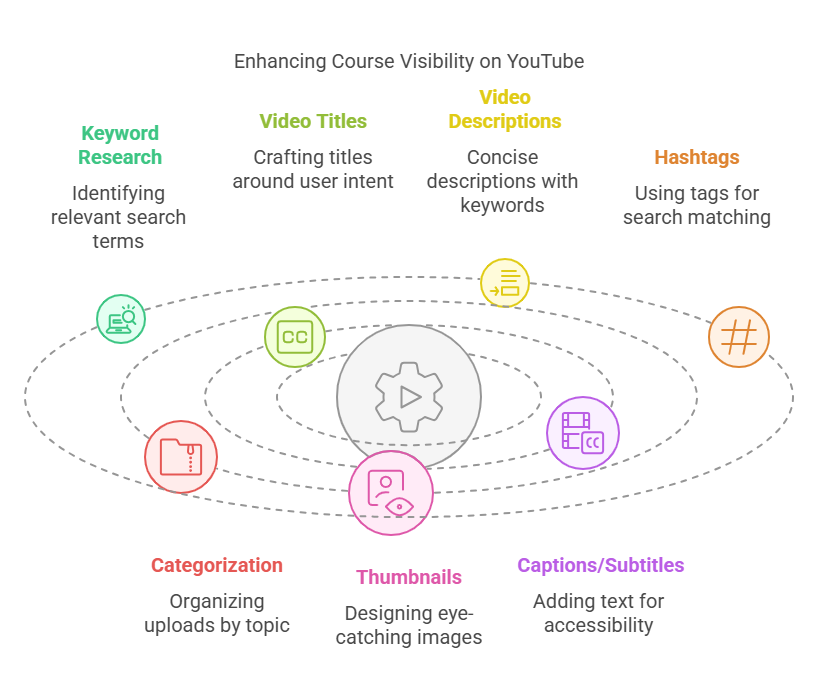
Increasing your course videos' visibility on YouTube can increase your revenue or course-selling percentage. Apply smart SEO methods and use YouTube's built-in tools to broaden your reach and draw in more viewers.
Research valuable terms using platforms like Semrush, Google Keyword Planner, or Ahrefs to find the most suitable search phrases.
Then, craft video titles around user intent by including these key terms. Similarly, name your video files with descriptive words to make them easier to find.
Keep video descriptions concise, ideally under 200 words, and place top keywords early. Update them regularly to stay fresh and maintain strong rankings.
Hashtags also help your videos gain traction. Add suitable tags because YouTube ranks videos higher when their tags match what people search for.
Another important step is categorizing your uploads. This tactic helps them show up in specific search filters and reach viewers who are interested in your topic.
Strong, appealing thumbnails can uplift clicks, so design images that grab attention.
To widen your audience further, add captions or subtitles. These help viewers with hearing issues and offer a friendlier viewing experience.
Show Video Testimonials and Reviews of Your Online Course Takers
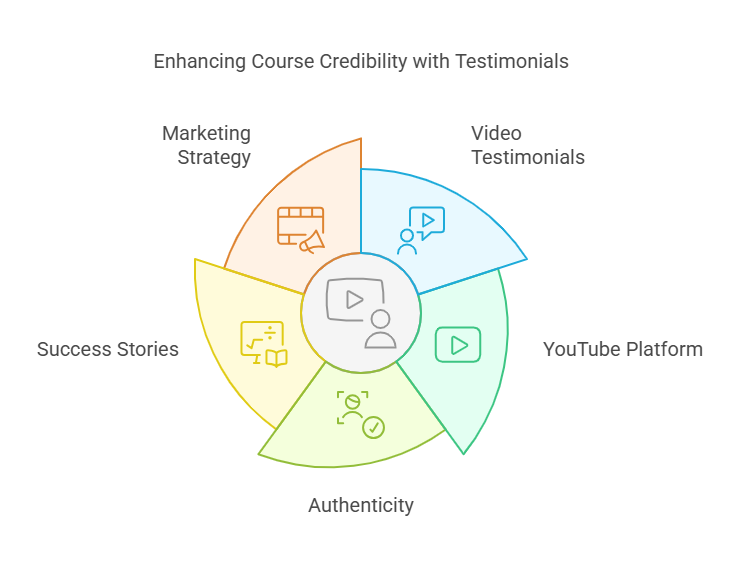
People want to hear real stories from learners who have completed your online courses. Potential students are motivated to sign up after seeing the honest feedback.
You can feature your course-related video testimonials and reviews on YouTube. This increases credibility and gives viewers a glimpse into the genuine value of your courses.
Start by contacting successful learners from various backgrounds. Ask them to record brief videos reflecting on their progress and achievements. Remind them to speak truthfully so their insights feel authentic.
Invite them to share a before-and-after look at their journey, if possible. When people see tangible improvement, they're more inclined to believe in your course's impact.
After collecting a range of testimonials, gather them into one playlist on your YouTube channel. This way, potential students can conveniently watch multiple success stories in one place.
Highlighting positive outcomes from real users shows viewers what they can accomplish. It also strengthens their confidence in your course.
By embedding these video testimonials into your broader YouTube marketing strategy, you can greatly improve your course's reputation. This provides solid proof of effectiveness and encourages viewers to enroll.
How to Turn Viewers Into Enrolled Students with EzyCourse
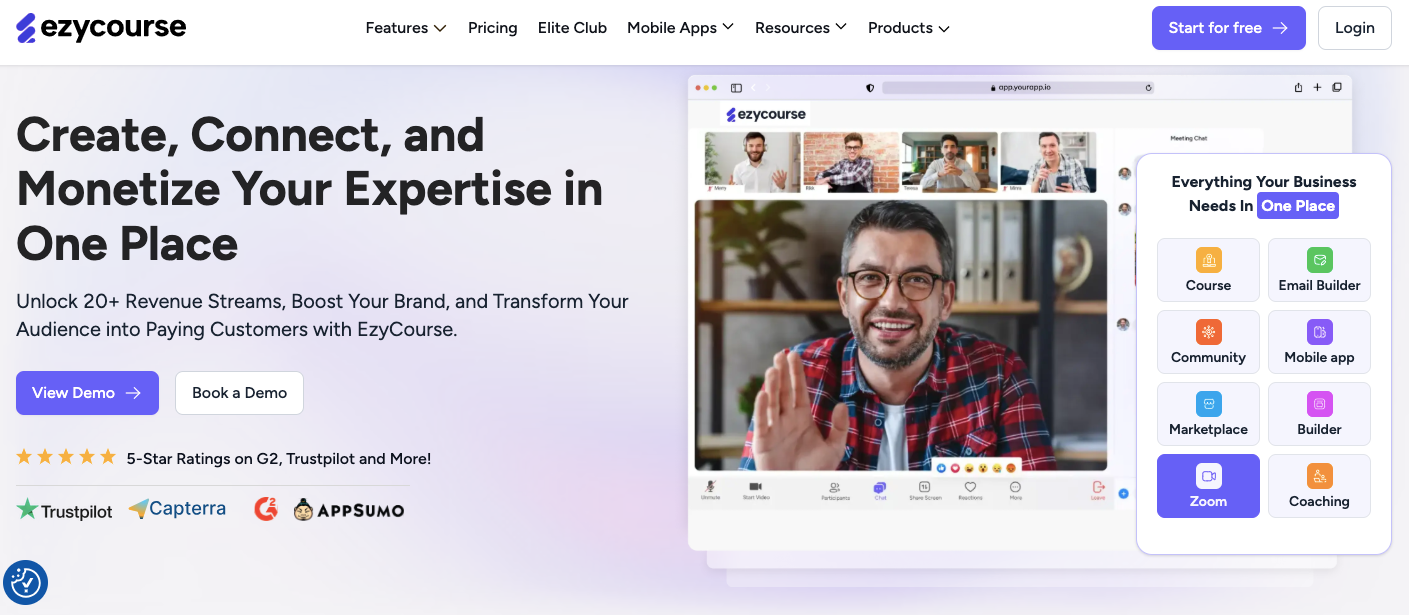
Now that you've attracted students through YouTube, the next step is to give them an exceptional course experience. And that’s where the all-in-one online course platform, EzyCourse, comes into play.
EzyCourse is an online course platform designed for creators who want to build, market, and sell online courses without juggling multiple tools. Whether you’re teaching coding, coaching life skills, or offering niche expertise, you’ll get everything you need in one place.
Key Features That Help You Create Better Courses
Course Builder: Create structured, high-converting courses with videos, quizzes, and resources.
Built-in Community: Let students engage with each other and with you inside a private learning space.
Coaching: Run 1:1 or group coaching for your students.
Memberships: Sell courses with membership-based plans.
Gamification: Add coins, badges, and leaderboards to make learning fun and addictive.
Live Classes & Webinars: Host real-time sessions right inside your course platform, no Zoom needed.
Built-in Community: Let students engage with each other and with you inside a private learning space.
White-label Mobile App: Get a fully branded mobile app for your course website.

EzyCourse Pricing

Whether you're just starting or scaling, EzyCourse has flexible plans:
Essential Plan: $59/month
Pro Plan: $139/month
Unlimited Plan: $199/month
Elite Plan: $299/month
*Pricing may be subject to change any time
Why EzyCourse Works for YouTube Creators
Instead of sending your YouTube traffic to scattered tools or complex funnels, EzyCourse acts as your central hub. You own the audience, control the experience, and keep more revenue.
EzyCourse lets you package your expertise into online courses, memberships, and digital products, so you can earn with multiple revenue streams. Ready to turn your content into a thriving course business? Try EzyCourse today!
Final Thoughts
You've now explored a complete guide to selling courses on YouTube. Millions of people visit online daily, and it's a perfect platform to launch your course business. You should focus on making high-quality, engaging videos that teach real skills.
High-quality courses and video content will build your subscriber base. And, you can offer your courses directly on your channel or through your own site. Keep polishing your content and fine-tuning your promotional approach.
Once your course is ready, you'll still need a reliable hosting solution for your landing page. That's where EzyCourse comes in. It equips you with everything required to build and sell your online course.
If you have any further questions on how to use YouTube to promote your online courses, you can reach out to us. EzyCourse experts are always there to help you!
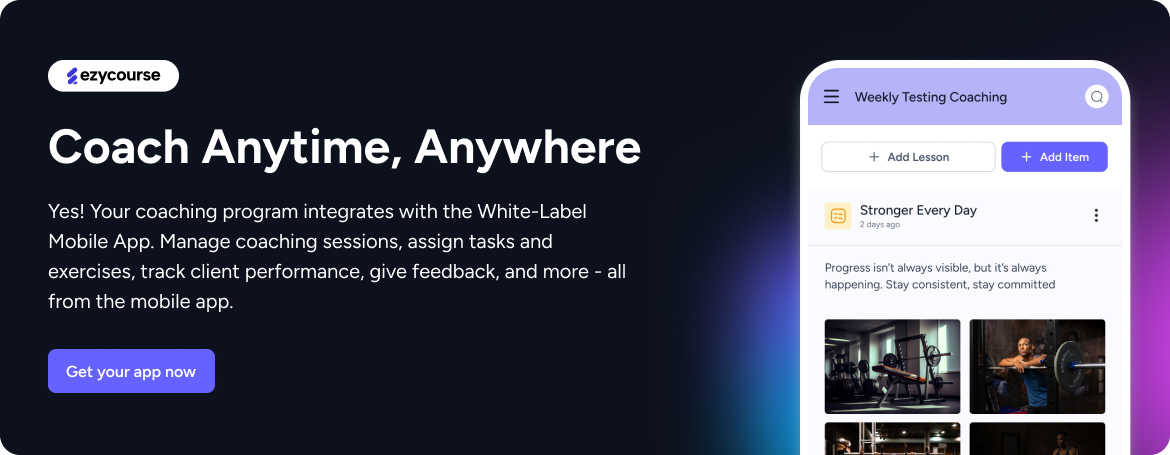
Frequently Asked Questions
How long does it take to see results from YouTube marketing?
Most course creators see initial engagement within 30-60 days, with significant student acquisition typically occurring after 3-6 months of consistent posting.
What's the minimum number of videos needed to start promoting courses?
Start promoting after 10-15 valuable videos to establish credibility and give viewers multiple touchpoints with your expertise.
Can you sell courses directly on YouTube?
YouTube doesn't process course payments directly, but you can use membership features or direct viewers to external platforms for enrollment.
What types of course content work best on YouTube?
Tutorial previews, behind-the-scenes content, student success stories, and "how-to" videos related to your course topic perform best. Educational content that solves specific problems generates the highest engagement.
Should I give away course content for free on YouTube?
Share valuable insights that complement your course without giving away everything. Use the 80/20 rule: provide 80% value in free content while reserving 20% of your best insights for paid courses.
How do I track YouTube marketing ROI for my courses?
Track metrics like:
Video views and engagement rates
Click-through rates to course landing pages
Conversion rates from YouTube traffic
Revenue generated from YouTube-sourced students
Cost per acquisition for paid promotion
Use YouTube Analytics combined with your course platform's tracking to measure effectiveness.
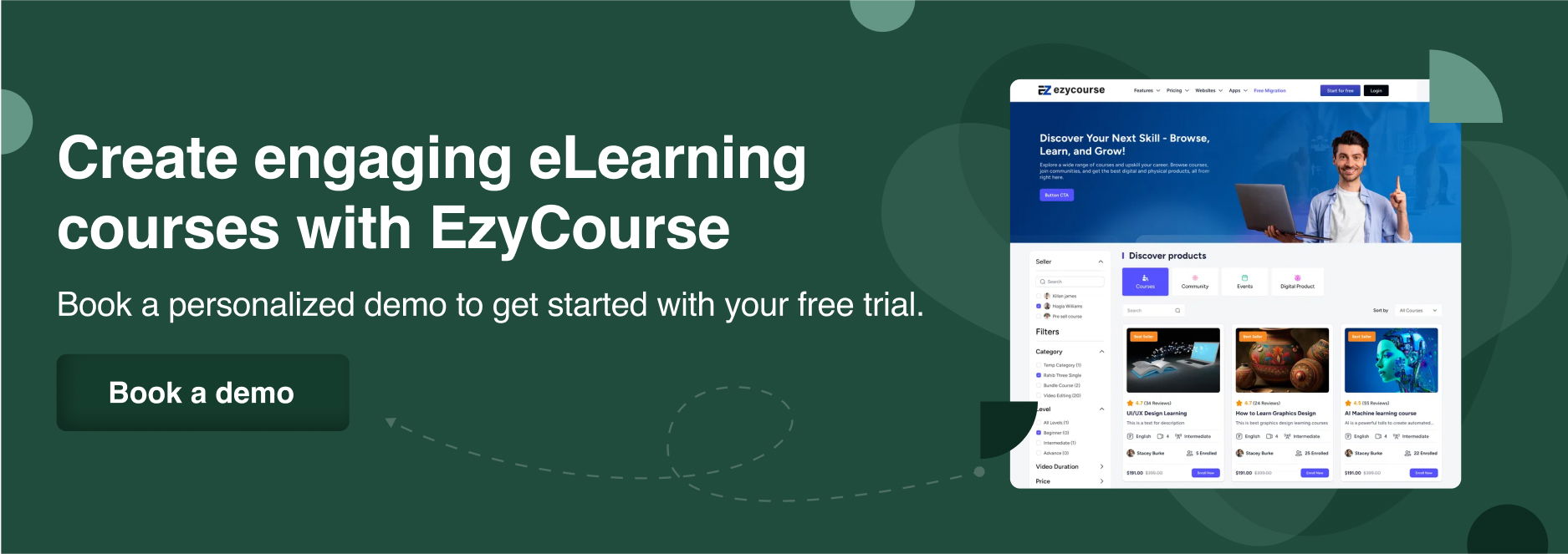
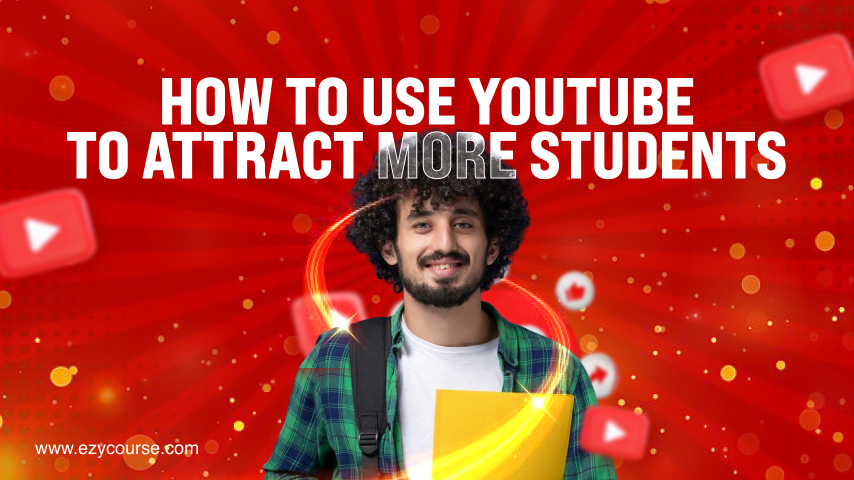


![What is the Best Platform to Sell Online for Beginners [2025]](/_next/image?url=https%3A%2F%2Fezycourse.b-cdn.net%2F2422%2Fcmgz2vbff08pjtt8ze5256ll6.png&w=1920&q=75)



